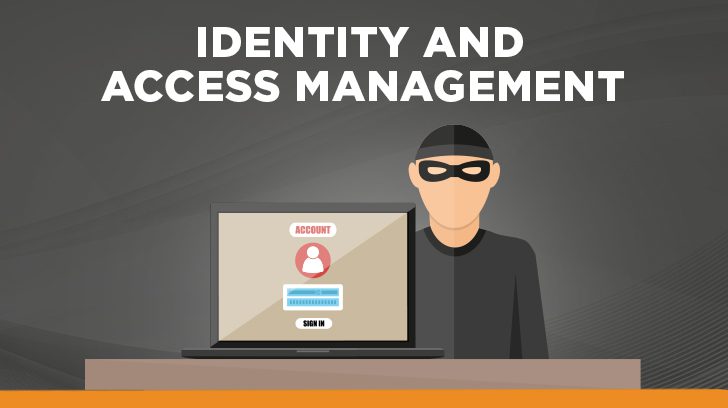How do companies keep track of who’s supposed to see what information? What if a disgruntled ex-employee still had access to sensitive files? Or a hacker could easily impersonate the CEO? Identity and Access Management (IAM) is the answer, ensuring the right people (and only the right people) get access to the right systems and data needed to perform their responsibilities.
What is Identity & Access Management?
Think of IAM as a high-tech security guard for your company’s digital assets. IAM ensures that employees, contractors, and even customers have access only to the information and tools they need to do their jobs. For instance, a salesperson might have access to customer contact info but not research and development files.
IAM doesn’t just give everyone the keys to the digital kingdom. Instead, an IAM system tailors access to what each person needs to be successful in their role. Let’s take a look at a few examples.

What is Identity In the World of IAM?
In Identity and Access Management, an identity is any person, device, or piece of software that needs access to your digital resources. Let’s break it down:
- Users: This includes your employees (from executives to interns with varying access needs), customers with accounts on your systems, and external partners or contractors.
- Devices: Anything that connects to your network becomes an identity. This means laptops, desktop computers, smartphones, tablets, and even ‘smart’ devices are part of the Internet of Things (IoT).
- Software (Applications): IAM doesn’t just manage people. Applications like your CRM (HubSpot, Salesforce, SugarCRM, etc.), email systems, financial software, or even cloud-based productivity suites are considered identities that require managed access.
What is Access? Understanding Permissions in IAM
In the world of IAM, access refers to what actions a specific identity (whether a user, a device, or a piece of software) is allowed to perform within your digital systems. This doesn’t just mean ‘allowed in’ or ‘blocked out.’ There are various levels of access:
- Read: The ability to view information.
- Write: The ability to create or modify data.
- Delete: The ability to remove information.
- Execute: The ability to run software or applications.
For example, a customer service representative might have ‘read and write’ access to a customer’s support ticket history. This allows them to view past issues and add updates to the ticket. However, they likely wouldn’t have ‘delete’ access to prevent accidental or unauthorized changes to the customer’s information.
IAM is used to carefully manage these types of access, based on users’ job functions, to protect sensitive data, and prevent misuse of systems. Next, we’ll discuss how IAM systems do this.

Authentication: Who Are You?
In IAM, authentication is all about proving you are who you say you are. Think of it like showing your ID to get into a club. Here are some ways IAM verifies your identity:
- Something You Know (Passwords): The classic login, but the weakest on its own. That’s why…
- Something You Have (Multifactor Authentication): This adds an extra layer of security – a one-time code sent to your phone, a physical security key, etc.
- Something You Are (Biometrics): Fingerprint scans or facial recognition are getting more common.
Authentication is the first line of defense. It stops hackers from pretending to be you and gaining access to your data.
Authorization: What Can You Do?
Once you are authenticated, the IAM knows who you are. However, IAM limits what you are allowed to do. Authorization is like the bouncer checking if you’re on the VIP list to access different areas. Here’s how it works:
- Permissions: These control what you can see and do within a system – access a specific folder, edit a document, or run a program.
- User Roles: Companies often assign job titles as roles with pre-set permissions. This makes management easier (‘Marketing Intern’ doesn’t need the same access as the ‘Finance Director’).
- Principle of Least Privilege: A core IAM rule! Users should only get the minimum access they need to get the job done. This keeps everyone (and your data!) safer.
The use of authorized permissions limits the damage that could be done if an account is compromised. It also prohibits legitimate users from mistakenly or intentionally accessing systems or data that are not necessary for their role.

Single Sign-On (SSO): Using One Login for Them All
It can be frustrating and difficult to remember a different login for every website and application that you use. Single Sign-On (SSO) solutions aim to solve this problem! Here’s the idea:
With SSO, you log in once with a central set of credentials to access all the company resources you’re authorized to use. A common example of this is the use of Microsoft or Google accounts to access various websites, or those corporate systems where one login gets you into email, HR software, and other SaaS applications.
SSO provides the following benefits:
- Convenience: Fewer passwords to remember = happy users!
- Improved Security: Centralized control can be easier to manage than many separate logins.
- Administration Efficiencies: A lot of IT professionals love when SSO is used because it simplifies and streamlines their workload for administering access within the organization.
SSO makes life easier for users, and that can often translate into better security practices.
Benefits of Robust IAM – Why It Matters for Your Business
Investing in a strong Identity and Access Management (IAM) system provides numerous advantages for your business. The following are a few examples:
- Prevent Data Breaches: IAM acts as a digital fortress, using tools like multi-factor authentication and the principle of least privilege to block unauthorized access and minimize the risk of costly data leaks.
- Improved Compliance: Meet stringent data security regulations like HIPAA, GDPR, PCI-DSS, and others with confidence. A robust IAM solution helps you track who has access to what and aligns with industry best practices.
- User Productivity: Reduce password fatigue and time wasted on access issues with Single Sign-On (SSO) and streamlined permission management. Employees spend more time on their actual work, increasing overall productivity.
- IT Efficiency: IAM centralizes control, making it easier for your IT team to add or remove users and manage access across the organization. This leads to a significant reduction in helpdesk tickets related to password resets and permissions.
IAM isn’t just about technology – it’s a strategic investment in safeguarding your data, aligning with regulations, and boosting your company’s overall efficiency.
Summary
Identity and Access Management (IAM) might seem technical, but at its core, it’s about protecting the things that matter: your company’s data, your customer’s privacy, and your reputation. Robust IAM is like installing a high-tech security system for your digital assets – it carefully controls who has access and what they can do.
IAM isn’t just an IT concern. It’s a wise investment in your company’s success and your peace of mind. If you would like to learn more about the intricacies of identity management, or if you are seeking professional guidance for an upcoming audit or certification process, please contact our team at Linford & Company.

Isaac Clarke is a partner at Linford & Co., LLP. He began his career with Ernst & Young in 2003 where he developed his audit expertise over a number of years. Isaac specializes in and has conducted numerous SOC 1 and SOC 2 examinations for a variety of companies—from startups to Fortune 100 companies. Isaac enjoys helping his clients understand and simplify their compliance activities. He is attentive to his clients’ needs and works meticulously to ensure that each examination and report meets professional standards.




